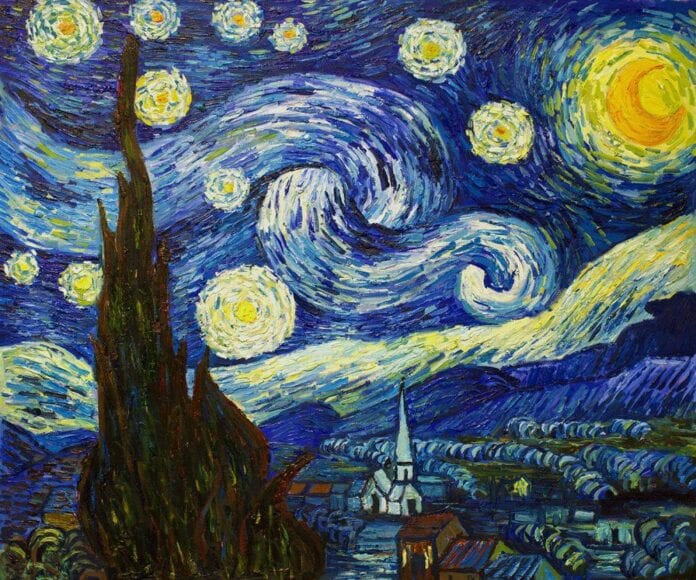When the puppies finished their last romp in the puppy yard, we sat in our small town on our evening stoop wrapped in summer’s warm embrace. The chickens had been secured in their coop. Our Aussie had been spritzed with Island Sunset (our favorite new puppy scent) and groomed—ear ruffs combed to keep the mats away, pantaloons brushed to stay soft and fluffy. Our Wheaten Terrier/Poodle, Chiquita, had gone upstairs to be “mise en place” on David’s side of the bed. Lasyrenn sat on the top step between my husband and me. We were all content and quiet, peaceful and enchanted as we watched our dusk-time entertainers softly scattered, silently, randomly lighting up our clover-crusted lawn.
They reminded me of those New York City evenings when mesmerized I stood on the Manhattan bluffs above the Hudson River entranced by a similar show. Those nights there seemed to be thousands of tiny fairies illuminating the black backdrop of the New Jersey Palisades from tree line above to water’s edge below. Where did they come from? Why were they putting on such an extravaganza?
Fireflies. Lightning bugs. Summertime insect fairies. We love them. As children my little brother David and I ran barefoot over the Bermuda and Saint Augustine sod to catch them in our hands and put them in glass Mason jars. We punched holes in the jar lids to give them air. We placed a wet paper towel on the bottom topped with a few blades of grass for a temporary habitat. We set the jars on our bedside tables and fell asleep watching our guests taking turns going on and off, on and off like the rhythm of a lullaby. Next morning with Mother’s reminding, we took our visitors back outside, opened the lids and lay our jars sideways on the ground. By lunchtime our wee fairies had all disappeared.
Fireflies. Who are they? Our fireflies are not flies at all. The Lampyridae family of insects is in the beetle order Coleoptera with over 2,000 described species. Their name is from the Greek “lampein” which means “to shine”. Commonly called fireflies or lightning bugs, they are soft-bodied beetles known for using twilight bioluminescence to attract mates for loving or prey for dinner.
Did you know firefly light can be yellow, green or orange? With regard to energy expended to make their flashes, fireflies are efficiency superstars using oxygen to mix with luciferin that generates light with very little heat.
Serving as courting overtures in the insect world, firefly flashes can be as romantic as a dozen roses given by a lover to woo the affection of another. Male fireflies typically fly through the air in search of a female by emitting a species-specific flashing pattern of one to nine flashes. The females resting on the ground wait until they see a truly impressive light display. They indicate their interest with a single flash in a species-specific manner, timed to echo the males’ flashing. Then, well, you know the story. In nature’s perfect timing a batch of new fireflies will be birthed into our world.
Regrettably, humans are contributing to the demise of our firefly populations. If you don’t see as many this summer as you have in the past, consider that light pollution, development of appropriated firefly habitats and agricultural harvesting are decreasing their homes and numbers. Fireflies do not relocate when their homes are overtaken. Sadly, these magical insects of summer just disappear. Where can we find inspiration and answers to show us how we can keep our romantic fireflies happy at home and lighting up night skies in our small town and everywhere?
So often as artists seeking inspiration David and I simply look up to lift our spirits and to invite intuitive insight and answers. On many a summer’s night we are awed by the hosts of stars and planets shining as though to ignite sparks of ideas within us as they echo the firefly light show twinkling before us.
Frequently our awe for the beauty and the grandness of our natural world turns our thoughts to our awe for the great art we both love—art like Vincent Van Gogh’s exquisite “Starry Night” that we viewed at the Museum of Modern Art on our recent trip to New York City.
Made in June of 1889, by this post-impressionist Dutch painter this famous oil on canvas describes the view from the east-facing window of Van Gogh’s asylum room at Saint-Rémy-de-Provence. Just before sunrise the firmaments radiantly shine over far pastures and the ideal, church steepled village added by the artist. Did Van Gogh see fireflies dancing on the asylum’s lawn the summer nights before and after he painted this sunrise?
In this sweet summer of 2019, in our small town beneath our own firefly-sprinkled starry nights may we each find all the inspirations and answers we seek. May they twinkle in our hearts and in our minds like magical lightning bugs happily dancing over all our twilight lawns and across all our evening pastures for ever and ever. Amen.





















